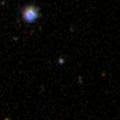275.23763 -14.33405 right side source
275.23312 -14.32476 above right source
There are many more, but these are the closest to the SNR
Starting with the peak of the extended SNR source, here's the result from several surveys (These are not as fun as SDSS)
275.24215 -14.33351:

So the positions of the sources nearest the SNR are:
USNO B1.0 with Gator:
At the position of the SNR, 275.24215 -14.33351, one source found within 5":
Distance: 3.711696"
RA: 274.241739, DEC:-14.332559, e_ra: 10, e_dec:999, b1_mag: null, r1_mag:18.83, no flags.
USNO B1.0 with "Integrated Image and Catalog Archive Service, the interface is pretty hard to make any certain conclusions from:

USNO A1.0 with the same "Integrated Image and Catalog Archive Service"

DSS seems to be pretty simple, but as the fields are dense, and the sources are close together, just looking at the results aren't too illuminative:
These are the images returned, in order of the positions listed above(the peak of the SNR flux, the source to the right, and the source above and to the right):

This so far is the best DSS query I can find- there is one on the MAST website, but it is not finding any results for the given positions in it's cross correlation query...
Just from looking at these, it seems a pretty good match for the source above at 275.23312, -14.32476, though I can't say much regarding the other two (it would have been nice to have a bright optical source associated with the xray source to the immediate right of the SNR..) Will keep trying to see if there is a better way to compare to DSS.
2Mass with Gator: no sources found within a five" radius.
This is slightly unsatisfying, as the optical catalogs don't agree conclusively. It appears that there is a possible match in the USNO B1.0 survey, but not so in A2.0.
Also, there could be a match in DSS, but it's hard to say, as it is only a picture.
At least we cannot conclusively say there ISN'T a match, unfortunately.






 I'm not quite sure what conclusions to draw from looking at spectra, looks like emission lines, which would also indicate a QSO- I know we are looking for a black body with lines indicating helium, but I'm not sure if these spectra are normalized in some way (this is probably very obvious but I'm not very used to interpreting spectra...) Also, this is kindof irrelevent if this is a galaxy, again.
I'm not quite sure what conclusions to draw from looking at spectra, looks like emission lines, which would also indicate a QSO- I know we are looking for a black body with lines indicating helium, but I'm not sure if these spectra are normalized in some way (this is probably very obvious but I'm not very used to interpreting spectra...) Also, this is kindof irrelevent if this is a galaxy, again.